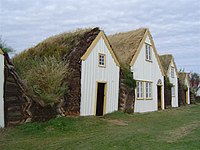Icelandic turf house

A long time ago in a place called Iceland, people didn't have the kind of houses that we have today. Instead of using wood and bricks like we do for our houses, they used a very special building technique called the Icelandic turf house.
So, what is a turf house? Imagine a tiny village made up of small and cozy little houses, each of which looks like a grassy hill with a door and maybe a few windows. These houses were built to keep people warm and safe from the cold and windy weather in Iceland, which is known to be very harsh.
Now, let's talk about how they built these houses. First, they started by digging a big hole in the ground that was the shape and size of the house they wanted to build. Then, they would lay down a wooden frame that would serve as the foundation and skeleton for the house.
Next came the fun part: covering the frame with sod and grass. Sod is a thick layer of earth that has grown as a thick mat of roots and soil, and is usually held together by grass. In Iceland, people would lay down these layers of sod and grass like shingles on a roof, building up to three levels of protection against the wind and cold.
The roof was made of turf and could be very thick, as much as 6 feet or more! It was so thick that sometimes people would even grow grass or vegetables on the roof! The thick walls and roof kept the heat inside the house, and people would use a fireplace or stove to keep warm.
Despite being built a long time ago, Icelandic turf houses are still popular today. They are a great way to experience what life was like in Iceland hundreds of years ago, and they are also a great example of how people can build their homes using materials found in nature.
So, what is a turf house? Imagine a tiny village made up of small and cozy little houses, each of which looks like a grassy hill with a door and maybe a few windows. These houses were built to keep people warm and safe from the cold and windy weather in Iceland, which is known to be very harsh.
Now, let's talk about how they built these houses. First, they started by digging a big hole in the ground that was the shape and size of the house they wanted to build. Then, they would lay down a wooden frame that would serve as the foundation and skeleton for the house.
Next came the fun part: covering the frame with sod and grass. Sod is a thick layer of earth that has grown as a thick mat of roots and soil, and is usually held together by grass. In Iceland, people would lay down these layers of sod and grass like shingles on a roof, building up to three levels of protection against the wind and cold.
The roof was made of turf and could be very thick, as much as 6 feet or more! It was so thick that sometimes people would even grow grass or vegetables on the roof! The thick walls and roof kept the heat inside the house, and people would use a fireplace or stove to keep warm.
Despite being built a long time ago, Icelandic turf houses are still popular today. They are a great way to experience what life was like in Iceland hundreds of years ago, and they are also a great example of how people can build their homes using materials found in nature.
Related topics others have asked about:
